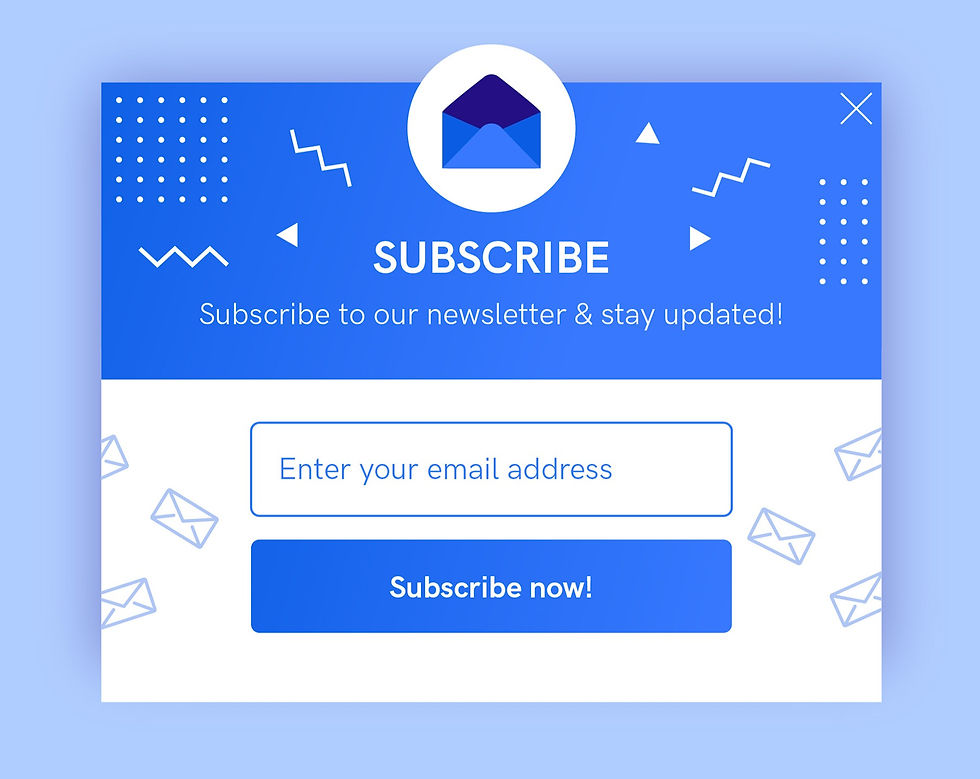What is a newsletter and how to incorporate it into your digital marketing strategy
- Estudio CKS

- May 15, 2024
- 6 min read
Updated: Mar 13
Would you like to gain subscribers, improve your relationship with current customers, and increase your sales? There is a very effective digital marketing strategy that can help you achieve these goals: email marketing. Email marketing involves the mass (but strategic) sending of emails to promote your brand.
Why should you try it? Because 99% of people check their email every day according to HubSpot statistics. And a surprising 59% of respondents say that marketing emails influence their purchasing decisions.
Among the email marketing services we offer, you will find different types of emails: announcements, newsletters, offers, and event invitations. However, in this post, we will talk about one of these types: newsletters. Pay attention, because today we will reveal what a newsletter is and how you can implement it successfully in your marketing campaign.

What is a Newsletter?
A newsletter is an email sent periodically to a list of subscribers who have shown interest in a business and want to receive information about it. These subscribers can be potential or current customers.
The goal of the newsletter is to provide information related to your company, advertise your products or services, share educational content, or update your subscribers on the latest news. The important thing is that it is a strategic newsletter focused on a specific audience.
The Purpose? To keep your business and your products or services in the minds of your subscribers and attract them to your website.
Why should you have a Newsletter?
Creating a newsletter can be beneficial for several reasons:
Direct Communication: Think of the statistic mentioned earlier: 99% of people check their email daily. If you want to communicate with your audience in a close, quick, and secure way, a newsletter is the perfect tool. Unlike social media, email is a more professional and personal channel, making the newsletter a safe and direct way to reach your subscribers. You can send them updates, news, relevant content, and any important information related to your business.
Customer Loyalty: By providing valuable content through a newsletter, you can strengthen the relationship with your current customers and increase loyalty to your brand. However, you should first know your buyer profile well to understand what type of content to send them.
Traffic and Conversion Generation: A well-crafted newsletter can generate traffic to your website, blog, or online store. By including links to your posts or featured products and calls to action (CTA), you can increase visits and possibly conversions.
Positioning as an Expert: By sharing relevant information, useful tips, and specialized knowledge, you can establish yourself as an expert in your industry. This helps build trust with your audience, and when they need a product or service, they will remember your brand.
Personalization: A newsletter allows you to personalize your messages according to your subscribers' interests. You can send specific and relevant content to different groups, thereby increasing the effectiveness of your communications.
Data Collection: With your newsletter, you can collect valuable data about your subscribers, such as their preferences, behaviors, and feedback. This will help you improve your products or services and your marketing strategy.
Low Cost: Unlike other marketing strategies, sending newsletters can be free depending on the platform you use. If you want to use a paid platform, the cost will depend on the number of subscribers and email sends.
How to create a Newsletter?
Now that you understand what a newsletter is for and why you should implement it in your marketing strategy, it’s time to design one. Here are the steps you should follow to create an effective newsletter:

Define a Goal for Your Newsletter
Determine Your Newsletter Strategy
Choose a Platform for Your Newsletter
Build a Subscriber List
Set Up a Newsletter Subscription Form
Attract Subscribers to Your Newsletter
1. Define a goal for your newsletter
First of all, you should set the goal of your newsletter. This goal will depend on the purpose and specific goals of your business. Do you want it to help you increase the number of prospects and attract more customers? Are you looking to retain your customers? Generate traffic? Increase your sales?
Once you have the goal, it’s important to know the audience you will be targeting. This will allow you to focus the content, tone, and promotional actions on your target market to make the strategy effective and maximize its impact. It’s useless to send news about local events to customers living in another region.
2. Determine your newsletter strategy

Now you need to consider what type of content aligns best with your goals. For example, if you want to increase sales, you can send promotional offers. On the other hand, if you want to retain customers, you can create premium content for your oldest customers.
Depending on the campaign, you can opt for an informative, invitation, content, loyalty, special campaign, personal, or promotional newsletter. It’s recommended to share a newsletter that contains minimal promotion to avoid ending up in the readers' junk folder. Try to offer relevant, educational, and useful content for your audience, such as exclusive information, practical tips, interesting news, or other topics your subscribers want to read.
Think about your favorite clothing brand. If they constantly send you newsletters to buy their products, instead of clicking on the email, you’ll want to unsubscribe. However, if the newsletters are about summer trends, the best ways to combine outfits, invite you to an exclusive event, or provide information about manufacturing improvements, you’re more likely to want to open the email.
3. Choose a platform for your newsletter
To send newsletters easily, analyze the results, and manage your database, you’ll need to choose a platform that offers email marketing services. There are several reliable email marketing tools available, and the important thing when deciding is that the platform adapts to your needs, preferences, and budget. Remember to evaluate your needs, the size of your subscriber list, the required features, and your budget before choosing a platform.
If you already have a Wix website, you can create mass email and newsletter campaigns that attract your audience and generate traffic to your webpage.
4. Build a subscriber list
A newsletter can’t function without an audience to send it to. To obtain your subscribers' email addresses, follow these tips:
5. Set up a newsletter subscription form

Add subscription forms to your website so people can receive your newsletter. We recommend using attractive titles and catchy CTAs. For example, you can use the title “Get 20% off your next purchase” and the CTA “I want it!”. Next to the CTA button, include a field for the subscriber's name and another for their email address.
Place these forms in strategic places on your website, such as in a pop-up, a sidebar, or a blog post. Ensure they are visible and easy to complete.
Remember that subscribers must authorize the use of their email addresses, so include text where they can confirm this.
6. Attract subscribers to your newsletter
There are several strategies to attract subscribers to your newsletter. In the previous example, we used the incentive strategy. To motivate people to subscribe, you can offer an incentive such as a discount, a free ebook, a downloadable guide, access to exclusive content, or any other valuable resource that is relevant to your audience.

Another strategy is to use your social media to promote your newsletter. Share snippets of interesting content and add a CTA to subscribe. Many people share a subscription link in their Instagram bio, a YouTube video, or a podcast.
Lastly, you can encourage your existing subscribers to share your newsletter with their friends or colleagues. To do this, include social media buttons in your emails or leave a message like: "If you enjoy this content, why not share it with others?"
Summary
In summary, newsletters are part of a company's email marketing strategy. They involve sending periodic emails to a list of subscribers with news about your brand, articles and tips, and promotions.
A newsletter is an effective and quick channel to achieve your goals, whether it’s generating leads, increasing traffic, or retaining customers. The key is to share valuable content with your subscribers. Now that you know what a newsletter is, are you ready to create one for your business? Start by choosing an email marketing service.
Source: WIX - Danae Salinas, Blogger & Marketing Specialist





